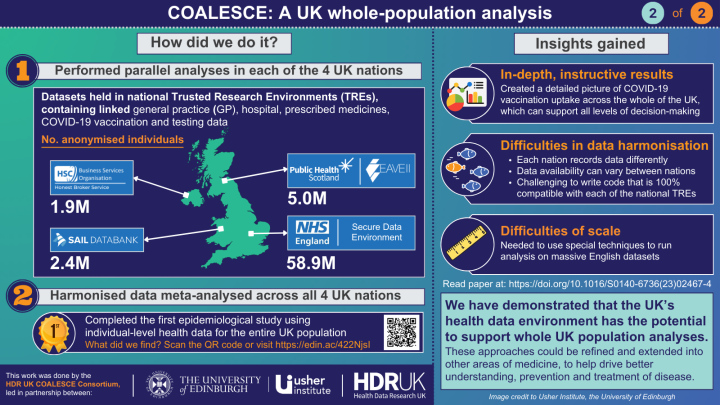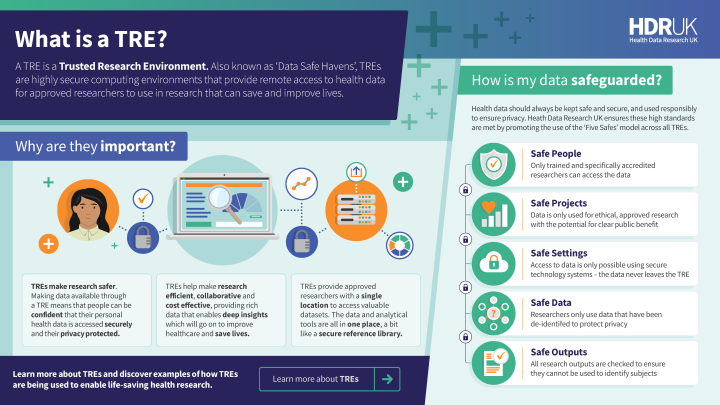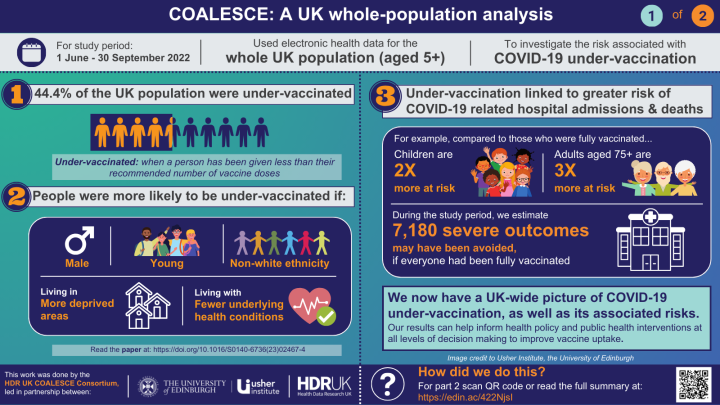The UK's first whole-population analysis
January 2024: Published in The Lancet, the UK’s epidemiological study of over 64 million people finds under-vaccinated people at higher risk for severe COVID-19
Under-vaccination and severe COVID-19 outcomes: meta-analysis of national cohort studies in England, Northern Ireland, Scotland and Wales
Kerr, S; Bedston, S; Cezard, G; Sampi, A; et.al
The Lancet
Published online on: 15 January 2024
Available online at: https://www.thelancet.com/journals/lancet/article/PIIS0140-6736(23)02467-4/fulltext
Summary in plain English
The UK’s COVID-19 vaccination programme began on 8 December 2020.
In this study, we looked at the de-identified Electronic Health Records (EHRs) of the whole UK population, to find out:
- Are people who are under-vaccinated at greater risk of experiencing severe COVID-19 illness (i.e. hospital admissions and/or deaths)?
- What characteristics make a person more likely to be under-vaccinated?
- What could have happened if everyone had been vaccinated by the start of our study period?
Why did we carry out this work?
While there is a lot of evidence showing that COVID-19 vaccines are effective in preventing COVID-19-related hospital admissions and deaths, far less is known about the risks associated with a person being under-vaccinated.
As more vaccine doses have been offered, the uptake for each dose has dropped.
For example, over 90% of the UK population had been given their first-dose vaccination by January 2022. In contrast, by August 2022, only 70% had received their first booster / third dose.
It is essential for us to find out how many people in the UK are under-vaccinated against COVID-19, understand the associated risks and identify opportunities to increase uptake.
How did we do this?

We looked at all children (aged 5+) and adults in the UK between 1 June and 30 September 2022.
To carry out this study, we used routinely collected health data from patients across the four UK nations. The datasets we used are stored within Trusted Research Environments (TREs).
| UK Nation | TRE / data partner | Size (million) |
| England | NHS England Secure Data Environment (via the British Heart Foundation Data Science Centre's COVID-IMPACT Consortium) | 58.9 |
| Northern Ireland | Honest Broker Service | 1.9 |
| Scotland | EAVE II (via Public Health Scotland) | 5.0 |
| Wales | SAIL Databank | 2.4 |
Trusted Research Environments (TRES) are highly secure computing environments providing remote access to health data for approved researchers. We use them to carry out research across various scientific domains, to save and improve lives.

Each of our data partners have their own processes for maintaining patient confidentiality and keeping data secure. Find out more by clicking on the links below.
SAIL Databank
Privacy by Design - SAIL Databank
EAVE II / PHS
Organisational background - Our privacy notice - Public Health Scotland
To make sure these datasets were kept safe, we analysed them within their respective TREs. We then pooled the results to perform a UK-wide meta-analysis, a statistical technique that combines the results of individual studies of a specific topic to calculate the ‘overall effect’.
A person was considered fully vaccinated if they received all their vaccine doses as recommended by the Joint Committee for Vaccination and Immunisation (JCVI) on June 1 2022. Those who did not were defined as under-vaccinated.
The JCVI recommended vaccination guidelines were:
- Ages 5-11: 1 dose
- Ages 12-15: 2 doses
- Ages 16-74: 3 doses
- Ages 75+: 4 doses
There is a small number of people who, due to being in higher risk clinical or demographic groups, were either offered further vaccine doses or recommended to not get their vaccines. We could not reliably identify these individuals, so instead grouped them as being ‘fully’ or ‘under’ vaccinated based on the guidelines above.
What did we find?

How many people were under-vaccinated?
On 1 June 2022, 44% of the population were under-vaccinated across the UK.
The proportion of people under-vaccinated in each of the four nations were:
- England: 46%
- Northern Ireland: 50%
- Scotland: 34%
- Wales: 33%
Who was most likely to be under-vaccinated?
We found people were more likely to be under-vaccinated if they were male, younger, from more deprived backgrounds, of non-white ethnicity or had fewer underlying health conditions.
For example, across the whole UK population:
- 63% of people aged 18-24 were under-vaccinated, compared to 20% of people aged 55-59
- 59% of people living in the most deprived areas, compared to 33% of people living in the least deprived areas
- 50% of people living with no underlying health conditions, compared to 26% of people living with five or more conditions
- 47% of males were under-vaccinated to, compared to 42% of females
- 39% of people of white ethnicity were under-vaccinated, compared to 74% of people of Black ethnicity*
*Ethnicity data is available for England, Scotland and Wales only.
Are under-vaccinated individuals at higher risk of severe outcomes?
In comparison to people who were fully vaccinated, people who were under-vaccinated were at higher risk for experiencing COVID-19 related hospital admissions and deaths.
For example, among people who did not receive any of their recommended doses:
- Children aged 5-15 were over two times more at risk
- Adults aged 16-74 were 50% more at risk
- Adults aged 75+ were over three times more at risk
Between 1 June and 30 September 2022, there were 40,393 COVID-19 related hospital admissions and deaths across the UK nations.
If everyone had been fully vaccinated by 1 June 2022, we estimate that there could have been 7,180 fewer COVID-19 related hospital admissions and deaths between 1 June and 30 September 2022.
Why is this important?
Our standardised analyses in each of the four nations have created a detailed, UK-wide picture of who is under-vaccinated against COVID-19 and the associated risks of under-vaccination. These results can be used to help create health policy and public health interventions to improve vaccine uptake.
This is the first epidemiological study to use individual-level EHR data covering the entire UK population. We have, therefore, demonstrated for the first time that the UK’s health data environment now has the potential to support whole-population level analyses.
The UK now has the opportunity to use its uniquely rich data in a safe and secure way, to answer questions related to endemic infectious diseases and major pressures facing the NHS.
Note
This summary was written by Communications & Engagement Officer Gabriella Linning. It was reviewed by members of our analyst team, as well as Patient and Public members Alan Keys and Karen Mooney.
This page was first published on 16 January 2024


